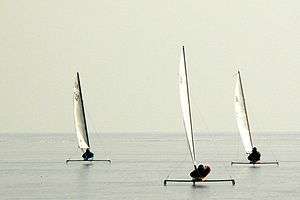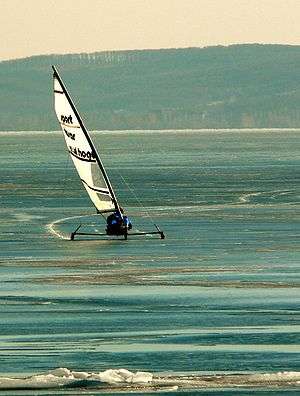Ice yachting
|
| |
| Presence | |
|---|---|
| Country or region | United States, Canada, Netherlands and Finland |
Ice yachting is the sport of sailing and racing iceboats, also called ice yachts.
International popularity
Ice yachting is practiced in Austria, Germany, Great Britain, Poland, Norway and Sweden, to some extent, and is very popular in the Netherlands and on the Gulf of Finland, but its highest development is in the United States and Canada. The Dutch ice yacht is a flat-bottomed boat resting crosswise upon a planking about three feet wide and sixteen long, to which are affixed four steel runners, one each at bow, stern and each end of the planking. The rudder is a fifth runner fixed to a tiller. Heavy mainsails and jibs are generally used and the boat is built more for safety than for speed. The iceboat of the Gulf of Finland is a V-shaped frame with a heavy plank running from bow to stern, in which the mast is stepped. The stern or steering runner is worked by a tiller or wheel. The sail is a large lug and the boom and gaff are attached to the mast by travelers. The passengers sit upon planks or rope netting. The Russian boats were faster than the Dutch-built ice yachts.[1]

History
18th century
Ice Yachting was born in Europe, but by 1790 the sport was in vogue on the Hudson River, its headquarters being in Poughkeepsie, New York.[2] The boat was a square box on three runners, the two forward runners being nailed to the box and the third acting as a rudder operated by a tiller. This type of boat was first built in 1790 by Oliver Booth of Poughkeepsie. At this time, during the early days of the sport, it was an activity for the masses and not only for the wealthy.[2]
19th century
The above primitive style was in general use until 1853, when triangular frames with boxes for the crew aft and jib and mainsail rig were introduced. Also at this time, the 1850s, ice yacht clubs were formed in Newburgh, New Hamburg, Poughkeepsie, and Hyde Park. Members of the various clubs competed to win races such as the Ice yacht Challnge Pennant of America and the Captain William Drake Flag. They also raced against the newly introduced trains that began running along the Hudson River. [2]
A heavy, hard-riding type soon developed, with short gaffs, low sails, large jibs and booms extending far over the stern. It was over-canvassed and the mast was stepped directly over the runner plank, bringing the centre of sail-balance so far aft that the boats were apt to run away, and the over-canvassing frequently caused the windward runner to swing up into the air to a dangerous height. The largest and fastest example of this type, which prevailed until 1879, was Commodore John. E. Roosevelt's first Icicle, which measured 69 ft (21 m) overall and carried 1,070 sq ft (99 m2) of canvas. The Icicle once beat the Chicago Express on its run from Poughkeepsie to Ossining.[2]
J.E. Roosevelt founded the Hudson River Ice Yacht Club in 1869. A 46-foot version of the Icicle recorded a speed of over 100 miles per hour.[3]
In 1879, H. Relyea built the Robert Scott, which had a single backbone and guy wires, and it became the model for all Hudson River ice yachts. Masts were now stepped farther forward, jibs were shortened, booms were cut down, and the center of sail-balance was brought more inboard and higher up, causing the centers of effort and resistance to come more in harmony. The shallow steering-box became elliptical.
The first race for the American Challenge Pennant occurred in 1881, which represents the championship of the Hudson River. The clubs that competed included the Hudson River, North Shrewsbury, Orange Lake, Newburgh and Carthage Ice Yacht Clubs. The races are usually sailed five times round a triangle of which each leg measures one mile, at least two of the legs being to windward.
20th century
In 1911 modern ice yachts were made of a single-piece backbone the entire length of the boat, and a runner-plank upon which it rests at right angles, the two forming a kite-shaped frame. The best woods for these pieces are basswood, butternut, and pine. They are cut from the log in such a way that the heart of the timber expands, giving the planks a permanent curve, which, in the finished boat, is turned upward. The two forward runners, usually made of soft cast iron and about 2.7 ft (1 m). long and 24 inches (61 cm) high, are set into oak frames a little over 5 feet long and 5 inches high. The runners have a cutting edge of 90%, though a V-shaped edge is often preferred for racing. The rudder is a runner about 3.7 ft (1 m). long, worked by a tiller, sometimes made very long, 7½ feet not being uncommon. This enables the helmsman to lie in the box at full length and steer with his feet, leaving his hands free to tend the sheet. Masts and spars are generally made hollow for racing-yachts and the rigging is pliable steel wire. The sails are of 10-ounce duck for a boat carrying 400 sq ft (40 m2) of canvas. They have very high peaks, short hoists and long booms. The mainsail and jib rig is general, but a double-masted lateen rig has been found advantageous. The foremost ice-yacht builder of America was G. E. Buckhout of Poughkeepsie.[1]

An ice yacht is about 40 ft (12 m) in length and can carry six or seven passengers or crew, who are distributed in such a manner as to preserve the balance of the boat. In a good breeze the crew lie out on the windward side of the runner-plank to balance the boat, and reduce the pressure on the leeward runner. A course of 20 miles (32 km) with many turns has been sailed on the Hudson in less than 48 minutes, the record for a measured mile with flying start being at the rate of about 72 miles (116 km) an hour. In a high wind, however, ice yachts often move at the rate of 85 and even 90 miles (145 km) an hour.[1]
On the bays near New York, a peculiar kind of iceboat has developed, called scooter, which may be described as a toboggan with a sail. A typical scooter is about 15 ft (5 m) long with an extreme beam of 5 ft (2 m), perfectly oval in form and flat. It has mainsail and jib carried on a mast 9 or 10 feet long and set well aft, and is provided with two long parallel metal runners. There is no rudder, the scooter being steered entirely by trimming the sails, particularly the jib. As the craft is flat and buoyant, it sails well in water, and can thus be used on very thin ice without danger. A speed of 50 km/h (31 mph) has been attained by a scooter.[1]
Classes of ice yachts
In the early 20th century ice yachts were divided into four classes, carrying respectively 600 sq ft (60 m2) of canvas or more, between 450 and 600, between 300 and 450, and less than 300 sq ft (30 m2). In the 1930s the Detroit News held a competition to design an inexpensive iceboat for ordinary (not wealthy) citizens. A new type of boat, known at the DN, resulted.[3] The prevalent yachts used today are known as "stern-steerers" because of the skate in the back which is used to steer them. They have a long central beam, often hollow, clamped to large runner planks close to the mast that carry the forward skates. The sailors ride in an oval pod at the stern, which often has elegant varnished rails and turned stiles. One sailor steers and the other works the sheets, or control lines for the sails. [3]
North American ice yachting
Ice yachting is very popular on the Great Lakes, both in the United States and Canada, the Kingston, Ontario Club having a fleet of over 25 sail. Other important centers of the sport are the Lake Geneva, Wisconsin area, with an average of twenty-five sailing days a season for the last five years, Lakes Minnetonka and White Bear in Minnesota, Lakes Winnebago and Pepin in Wisconsin, Bar Harbor Lake in Maine, the St. Lawrence River, Quinte Bay and Lake Champlain.[1]
See also
References
- 1 2 3 4 5

- 1 2 3 4 "A History of Ice Yachting in the Hudson Valley". www.hvmag.com. Retrieved 2018-02-21.
- 1 2 3 Fisher, Daniel (7 March 2014). "As The Hudson River Freezes, Classic Ice Yachts Emerge". Forbes. Retrieved 21 February 2018.
External links
| Wikimedia Commons has media related to Ice sailing. |